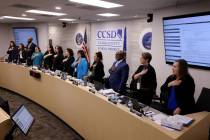EDITORIAL: ‘I think we have to look at the data’ on virus surge
As coronavirus cases surge in Nevada and elsewhere, it is significant that a concurrent increase in deaths has not yet followed. This reality too often gets lost amid the seemingly daily drumbeat of gloom and doom. Yet it is vital to accurately assessing the pandemic.
Nationally, the country hit a high in new cases on Thursday with more than 57,000 positive tests. By Sunday, that had fallen to about 44,500. Over the same period, Reason magazine’s Jacob Sullum reports, deaths fell from 636 to 251. By comparison, more than 2,700 Americans fell victim to the virus on April 21, the deadliest day so far.
Even in states with the biggest current outbreaks — Florida, Texas and California — fatalities have climbed only minimally in recent weeks. For instance, Mr. Sullum reports that the number of people testing positive in Texas increased 13-fold between May 25 and July 4, while the rolling seven-day average of deaths in the Lone Star State has jumped from 26 to 32. A similar trend has emerged in Nevada. Despite steady increases in new cases during much of June, fatalities have not kept pace, even allowing for lag time.
“So far,” The New York Times noted over the weekend, “the death toll has not climbed much in Texas and other parts of the South and West seeing a surge.”
Dr. Marc Boom, president and chief executive of Houston Methodist Hospital, told the Times that the coronavirus patient profile is much different than it was in March and April — in a good way. “We are having to pioneer the way of trying to understand a different curve with some very good characteristics versus the last curve,” he said.
Many patients showing up at the hospital, an emergency room doctor told the paper, are younger and in less distress and don’t need to be admitted.
In Texas, “90 percent-plus of ICU beds are occupied, but only 15 percent are COVID patients. Eighty-five percent of the occupied beds are not COVID patients,” noted Dr. Scott Atlas, a public health scholar at Stanford’s Hoover Institution. “I think we have to look at the data and be aware that it doesn’t matter if younger, healthier people get infected. I don’t know how often that has to be said, they have nearly zero risk of a problem from this. The only thing that counts are the older, more vulnerable people getting infected. And there’s no evidence that they really are.”
Contrary to President Donald Trump’s assertion, increased testing is not the sole cause for the rise in infections. But a massively expanded testing regimen has indeed identified more mild cases in younger people and doctors now have more experience treating the disease. No one knows what lurks ahead, of course. Current trends, however, indicate the coronavirus is far less deadly than once feared — remember warnings about 2 million American deaths? — and that’s reason for cautious optimism.




























